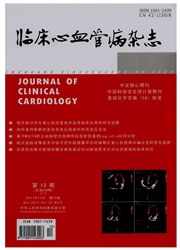

 中文摘要:
中文摘要:
目的:探讨山莨菪碱联合地尔硫冠状动脉(冠脉)注射对急性ST段抬高型心肌梗死(STEMI)直接经皮冠脉介入治疗(PCI)术后的造影结果及临床预后的影响。方法:本研究为前瞻性随机对照研究,选择STEMI行直接PCI术的患者随机给予冠脉内联合注射山莨菪碱及地尔硫(联合给药组)或0.9%氯化钠溶液(对照组),记录临床及冠脉造影特征并随访6个月。主要终点为无复流发生率,次要终点为主要心脏不良事件(MACEs)发生率。结果:联合给药组与对照组达到心肌梗死溶栓治疗(TIMI)血流分级3级比例分别为92.6%与72.2%(P=0.01),TIMI心肌灌注分级3级分别为68.5%与42.6%(P=0.012)。联合给药组较对照组获得更好的术后即刻cTFC结果(30︰46,P〈0.000 1)。术后单导联ST段抬高完全回落(〉70%)在联合给药组更常见。术后1周联合给药组高敏C反应蛋白水平明显低于对照组[(7.7±0.8)mg/L︰(9.3±1.1)mg/L,P〈0.001]。联合给药组缓慢性(7.4%︰24.1%,P=0.032)及快速性心律失常(3.7%︰18.5%,P=0.029)发生率均低于对照组。6个月时左室射血分数在联合给药组为(59.2±12.3)%,而对照组为(51.2±13.4)%(P=0.002)。Kaplan-Meier生存曲线评估联合终点随时间累积无MACEs生存率的比较差异无统计学意义。结论:预防性冠脉内联合应用山莨菪碱与地尔硫可降低急诊PCI术中无复流的发生,降低心律失常的发生率。
 英文摘要:
英文摘要:
Objective:To examine the role of intracoronary anisodamine and diltiazem administration on the angiographic and clinical outcome in patients with ST-segment elevation myocardial infarction(STEMI)undergoing primary percutaneous coronary intervention(PCI).Method:This study is a prospective,randomized,control study.STEMI patients who underwent successful primary PCI were randomized to two bolus injections of intracoronary anisodamine and diltiazem(the Combination Group)or saline(the Contorl group).Clinical and angiographic characteristics were observed.The primary endpoint was the incidence of no reflow.The secondary endpoints were MACEs including death,nonfatal myocardial infarction,and target vessel revascularization.Result:The percent of thrombolysis in myocardial infarction(TIMI)flow grade 3and TIMI myocardial perfusion grade 3were found to be significantly higher in the COM group than in the control group(respectively,92.6% vs 72.2%,P=0.010;68.5% vs 42.6%,P=0.012).Corrected TIMI frame count was significantly lower in the COM group than in the control group immediately after PCI(30vs 46,P〈0.0001).Resolution of single lead max ST-segment elevation(〉70%)was more frequently observed in the COM group than in the control group.The levels of hsCRP in the COM group was significantly lower than in the diltiazem group(7.7±0.8vs 9.3±1.1,P〈0.001).The COM group showed low incidences of bradyarrhythmia and rapid arrhythmia(respectively,7.4% vs 24.1%,P=0.032 and 3.7vs 18.5%,P=0.029).Left ventricular ejection fraction at 6months after PCI was 59.2%±12.3%in patients randomized to intracoronary anisodamine and diltiazem versus 51.2% ±13.4% in the control group(P=0.002).There was no difference in Kaplan-Meier curve of MACEs free survival rate between the two groups at 6months(log-rankχ^2=2.853,P=0.091).Conclusion:Intracoronary anisodamine and diltiazem administration before stenting prevents no reflow and arrhythmia rates in patients with STEMI undergoing PCI.
 同期刊论文项目
同期刊论文项目
 同项目期刊论文
同项目期刊论文
 期刊信息
期刊信息
